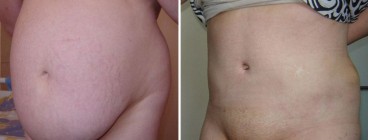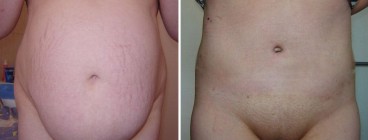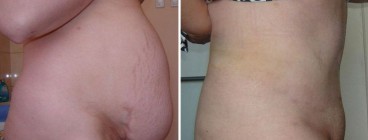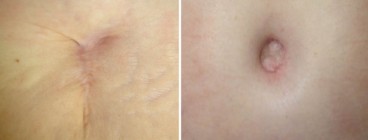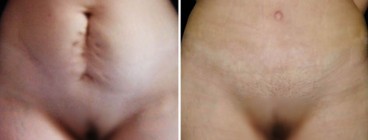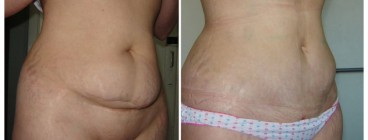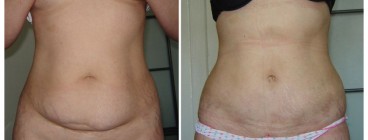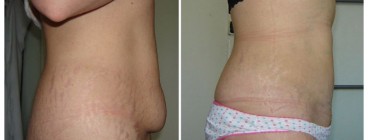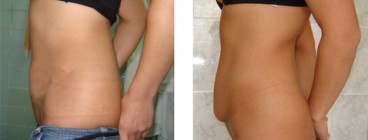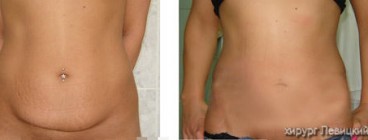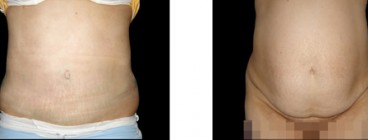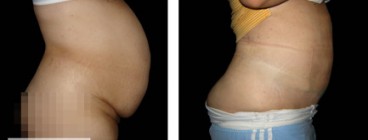
Tummy Tuck or Abdominoplasty
Abdominoplasty or Tummy Tuck is a Cosmetic Plastic Surgery procedure to remove excess skin from the lower abdomen after pregnancy or significant weight loss. This procedure can dramatically reduce the appearance of a protruding abdomen. This procedure can also be used to remove significant amounts of lower abdominal fat, and to thin the upper abdominal fat by elevating and redistributing it. Stretch marks below the level of the belly button are removed along with full thickness skin and fat down to the abdominal muscles. The abdominal muscles are sewn tightly together in the midline to strengthen the abdominal wall and accent the waist line before sharing the remaining upper abdominal skin to resurface the entire abdomen. The belly button is saved and brought through the remaining skin at the appropriate level, recontouring the abdomen in exchange for a low abdominal scar which will hide in underwear or a bathing suit , and will fade with time. This surgery always requires placement of temporary rubber drains to prevent fluid accumulation post-op, and is usually performed as an outpatient under general anesthesia. Down-time is about 10-14 days for light work, and 3-5 weeks before full exercise can be resumed. Abdominal Liposuction is not advisable at the time of full Abdominoplasty, but other areas such as the hips and thighs can safely be treated at the same time. Representative patient photos are shown below.
Best candidates for abdominoplasty
The best candidates for abdominoplasty are women or men who are in relatively good shape but are bothered by a large fat deposit and or loose abdominal skin that will not respond to diet nor exercise. The surgery is particularly helpful to women who, through the stretching of multiple pregnancies, have abdominal muscles and skin that will no longer return to normal. Lost skin elasticity in older patients, which frequently occurs with slight obesity, can also be improved. Women planning future pregnancies should consider waiting. The muscles tightened during abdominoplasty can separate again during pregnancy. Skin restretched may again not return to normal proportions. Previous abdominal scars need to be evaluated during an in office examination to see if they might effect possible surgery. Prominent abdominal contour scars like those sometimes seen after Caesarian delivery and other surgery can be improved during this abdominal sculpting.
Abdominoplasty can enhance your appearance and your self-confidence. It will not necessarily change your looks to match your ideal or cause other people to treat your differently. Think carefully about what this surgery has to offer. Reasonable expectations are essential to a happy outcome.
Weight loss and tummy tuck.
If you are planning to lose a lot of weight, abdominoplasty is best after the weight is stabilized. The skin and flesh are then sculpted to your new form. Massive weight loss after abdominoplasty may leave the skin loose again about the belly. One of the major fat storage areas of the body is the apron of fat around the intestines (omentum). This fat is located behind the abdominal wall and is not treatable with either liposuction or abdominoplasty. This surgery is for sculpture, not weight loss. Weight loss better done with controlled diet and improved eating exercise habits. If you maintain a positive caloric balance after surgery, you will regain your weight.
The surgery
This surgery is designed to remove and redrape redundant lower and middle abdominal wall skin and fat. An incision above the pubic region and extending towards the hips places the scar where it can hidden by most clothing. Skin and fat are separated from the underlying fascia (layer covering the muscles of the abdominal wall). In the standard operation this dissection continues up to the ribs exposing the vertical muscles (rectus muscles). The skin around the belly button (navel or umbilicus) is divided so the redundant tissue of the upper abdomen can be pulled down. This hole will frequently be pulled far enough down to be removed with the excess tissue. When less tissue needs to be removed, this hole may become a short vertical component of the lower scar.
In a “mini tummy tuck” there is a more limited region dissected and the bellybutton either left in place or repositioned with other techniques. When the navel is left tethered and enough tissue tightening performed, there may be distortion and an unnatural shape to the belly button.
The abdominal wall muscles are then drawn together in the midline narrowing the waistline. This stitching firms the abdominal wall and removes some bulging.
The skin flap is then stretched down and the extra skin removed. A new hole is cut for the navel and contoured to create its shape. The tissues are now sewn into place. Some of the sutures are deeper and will dissolve over time. More superficial sutures are removed in office after surgery. Special tape strips may further align the skin. Temporary drain tube(s) may be placed to remove fluid from under the flap. If present, you will be shown how to record the output from these drains. Dressings applied usually include one around the new navel and possibly one over the main incision.
Complete abdominoplasty usually takes two to three hours, depending on the extent of work required. Partial abdominoplasty (mini tummy tuck) may take only an hour or two of operating room time.

